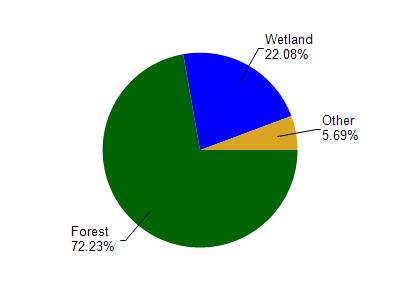Douglas
Yes
Yes
No
Fish and Aquatic Life
Overview
This high quality trout stream meets the West Fork Bois Brule River to form the Bois Brule River. In addition to the massive springs at its headwaters, Beaupre Springs and an unnamed spring poind at T45N R11W S9 also contribute significant spring water to the stream. Surveys in the 1970s report that both springs and their outlet streams support brook trout.
During survey work conducted as part of the coastal wetlands evaluation, three rare species of macroinvertebrate were found in the unnamed spring at T45N R11W S9 and the overall taxa richness of the east fork, Lynch Springs, Beaupre Springs and the unnamed springs was moderate (5-24 species) (Epstein 1997). The survey noted natural conditions and impoundment had some impact on habitat and evidence of significant aquatic plants, filamentous algae and iron bacteria were found in some areas. Construction may be a potential threat at Lynch Springs.
Date 1999
Author Aquatic Biologist
Condition
Wisconsin has over 84,000 miles of streams, 15,000 lakes and milllions of acres of wetlands. Assessing the condition of this vast amount of water is challenging. The state's water monitoring program uses a media-based, cross-program approach to analyze water condition. An updated monitoring strategy (2015-2020) is now available. Compliance with Clean Water Act fishable, swimmable standards are located in the Executive Summary of Water Condition in 2018. See also the 'monitoring and projects' tab.
Management Goals
Wisconsin's Water Quality Standards provide qualitative and quantitative goals for waters that are protective of Fishable, Swimmable conditions [Learn more]. Waters that do not meet water quality standards are considered impaired and restoration actions are planned and carried out until the water is once again fishable and swimmable
Management goals can include creation or implementation of a Total Maximum Daily Load analysis, a Nine Key Element Plan, or other restoration work, education and outreach and more. If specific recommendations exist for this water, they will be displayed below online.
Monitoring
Monitoring the condition of a river, stream, or lake includes gathering physical, chemical, biological, and habitat data. Comprehensive studies often gather all these parameters in great detail, while lighter assessment events will involve sampling physical, chemical and biological data such as macroinvertebrates. Aquatic macroinvertebrates and fish communities integrate watershed or catchment condition, providing great insight into overall ecosystem health. Chemical and habitat parameters tell researchers more about human induced problems including contaminated runoff, point source dischargers, or habitat issues that foster or limit the potential of aquatic communities to thrive in a given area. Wisconsin's Water Monitoring Strategy was recenty updated.
Grants and Management Projects
| Project Name (Click for Details) | Year Started |
|---|
|
|
Monitoring Projects
| WBIC | Official Waterbody Name | Station ID | Station Name | Earliest Fieldwork Date | Latest Fieldwork Date | View Station | View Data |
|---|
| 2870900 | East Fork Bois Brule River | 10034830 | E fork Bois Brule River | | | Map | Data |
| 2870900 | East Fork Bois Brule River | 10053713 | East Branch Bois Brule River 140m US Confluence | 7/29/2019 | 7/29/2019 | Map | Data |
|

Watershed Characteristics
East Fork Bois Brule River is located in the Bois Brule River watershed which is 199.64 mi². Land use in the watershed is primarily forest (72.30%), wetland (22.10%) and a mix of grassland (3.40%) and other uses (2.30%). This watershed has 220.94 stream miles, 3,539.94 lake acres and 18,373.66 wetland acres.
Nonpoint Source Characteristics
This watershed is ranked Not Ranked for runoff impacts on streams, Not Available for runoff impacts on lakes and Low for runoff impacts on groundwater and therefore has an overall rank of Low. This value can be used in ranking the watershed or individual waterbodies for grant funding under state and county programs.However, all waters are affected by diffuse pollutant sources regardless of initial water quality. Applications for specific runoff projects under state or county grant programs may be pursued. For more information, go to surface water program grants.